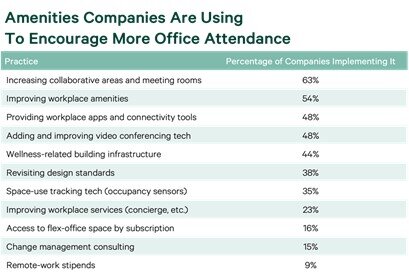Commercial Real Estate News

Office Tenants and Their Employees Have Widening Gap in Return-to-Work Expectations
Commercial News » New York City Edition | By Michael Gerrity | September 13, 2022 8:02 AM ET
Based on a new survey by CBRE of 176 U.S. companies shows that a wide gap between manager and employee sentiment persists when it comes to regular attendance in the office--leaving open the question of whether employees will actually return at a regular cadence that endures over time.
The survey, conducted for CBRE in August by CoreNet Global, gauged the sentiments of senior leaders at 176 companies in the U.S. and Canada on topics such as the progress of their return to the office, the amenities they have added or improved, and their plans for expanding or contracting their office portfolios.
In the first eight months of this year, many companies sought to ease employees back to their offices rather than mandate attendance. This month several high profile companies have attracted headlines by enacting firmer attendance guidelines, and anecdotal accounts this week describe busier commutes in some markets.
Still, CBRE's survey found just last month that 58 percent of companies reported employees were working in the office less often than executives expected. That's in comparison to 39 percent that said attendance was ideal and 3 percent that said it was more than anticipated.
The main question, then, is what managers are doing about it? The survey found that 36 percent of companies have set corporate expectations for office attendance, 25 percent have allowed managers and teams to set attendance expectations and 19 percent have set no guidelines. A further 16 percent have allowed a combination of managers and employees together to set the guidelines and 4 percent have left it to employees to decide for themselves.
Most companies aren't enacting strict attendance mandates. That puts more importance on the methods and tools managers are using to encourage employees to come into the office - but the most popular so far are fairly passive. Most companies in the survey (62 percent) are simply sending memos to employees about policies and expectations for office attendance. Fewer (41 percent) are explaining to employees why a return to the office matters for their company. Fewer still (29 percent) are surveying employees about their needs and preferences. Among the least popular methods (18 percent) is training for managers to guide and evaluate employees' behaviors around office attendance.
"To change organizational behavior, companies need to focus on creating new practices and implementing new tools to help drive a new normal," said Julie Whelan, CBRE Global Head of Occupier Research. "This is less about iterating on what was. It's about working to change behaviors based on a new set of norms and principles."
To that end, some companies (36 percent) are highlighting best practices and encouraging transparency about office attendance. The former can entail counseling managers to lead by example and advising teams to set certain days of the week to meet in the office. The latter can entail providing workplace apps that allow employees to see who will be in the office on which days so they can coordinate in-person meetings.
"Attendance mandates have their place in addition to the many tools available to encourage employees to visit the office more frequently: in-office tech, better office design, amenities and events that promote collaboration and use of the office," said Manish Kashyap, CBRE Global President of Advisory & Transaction Services.
The survey also gauged companies' sentiment on expansion or contraction of their office portfolios. It found that, while the largest portion of companies anticipate their portfolios contracting over the next three years, a growing number foresee theirs expanding.
Specifically, 31 percent of companies said they anticipate adding to their office portfolio over the next three years, 19 percent foresee it remaining the same and 46 percent see it getting smaller. That's a change in some cases from the past 20 months: Only 20 percent of companies said their office portfolios had expanded since January 2021, while 31 percent were unchanged and 44 percent had shrunk. In each timeframe, 4 percent of companies were unsure if change had taken place.
Sign Up Free | The WPJ Weekly Newsletter
Relevant real estate news.
Actionable market intelligence.
Right to your inbox every week.
Real Estate Listings Showcase
Related News Stories
Commercial Real Estate Headlines
- One Trillion Dollars of America's Commercial Property Loans Mature in 2025
- U.S. West Coast Dominates Self Storage Demand
- Phoenix, Orange County and Inland Empire Emerge as Leading U.S. Industrial Markets
- U.S. Mega Distribution Centers Leasing Activity Grew in 2024
- U.S. Commercial Borrowing to Increase to $583 Billion in 2025, Up 16 Percent Annually
- Demand for U.S. Life Sciences Space Spikes 28 Percent Annually in Late 2024
- Multifamily Property Sector in America Rebounding
- Asia Pacific Commercial Property Investment Spikes 23 Percent in 2024
- U.S. Commercial Property Market Primed for Growth in 2025
- Architecture Industry Sees Mixed Signals as 2025 Approaches
- Global Data Center Demand Spikes in 2025
- 2025 Prediction: U.S. Commercial Investment Recovery Expected to Gain Traction
- Holiday Retail Sales for 2024 to Hit Record $1 Trillion
- Tech, AI Industries Drive Largest Share of Office Leasing Activity in U.S.
- Commercial Real Estate Lending in U.S. Enjoys Strong Growth in Q3
- U.S. Multifamily Market Begins Recovery in Q3
- Commercial Investment in Japan Spikes 24 Percent Annually in Q3
- Despite Return-to-Office Mandates, U.S. Office Vacancies Continue to Rise
- PROPSIG Tech Startup Acquired by World Property Data
- U.S. Commercial Mortgage Debt Hits $4.7 Trillion in Q2 as Delinquencies Increase
- Hong Kong Class A Office Rents Continue to Downtick in Mid-Summer
- U.S. Office Landlords Tenant Concessions Decline for First Time in 4 Years
- U.S. Commercial Mortgage Originations Spike 27 Percent in Q2 Over Q1
- Phnom Penh's Commercial Office, Retail Markets Face Slowdowns in 2024
- Global Edge Data Center Market to Hit $300 Billion by 2026
- Commercial Property Transactions in Japan Dive 25 Percent Annually in Q2
- Delinquency Rates for U.S. Commercial Property Loans Downticks in Q2
- Megawarehouse Lease Deals in U.S. Increase in 2024
- Office Tenants' Flight to Quality Buildings Increases in 2024
- Commercial Lending in Japan Upticks 6 Percent Annually in Q1
- AI Driving Significant Global Data Center Growth in 2024
- Total U.S. Commercial Mortgage Debt Rises to $4.7 Trillion in Q1
- U.S. Commercial Mortgage Delinquencies Rise in Early 2024
- Asia Pacific Office Sector to Further Reprice Throughout 2024
- U.S. Retail Foot Traffic to Surpass Pre-Pandemic Levels by 2025
- Commercial Real Estate Lending in U.S. Slowed in First Quarter
- Japan Commercial Property Investment Volume Jumps 7 Percent in Q1
- Asia Pacific Commercial Property Investment Leads the World, Spikes 13 Percent
- Driven by High Rates, U.S. Commercial Lending Imploded 47 Percent in 2023
- After Two Year Slump, Prime Multifamily Metrics Uptick in U.S.






